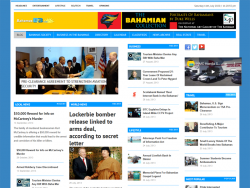Technology has so aided counterfeiters that perhaps the best way to eliminate the crime is to get rid of every home computer in the country, suggested Supt. Glen Miller of the Commercial Crimes Unit of the Royal Bahamas Police Force.
The problem, he said, is more prevalent in New Providence and Grand Bahama than the rest of the islands.
“Whenever one person is able to reproduce one note, that is a problem,” he said, “and it’s something we want to address. We have definitely seen the counterfeit $10 and $100 notes surfacing in Nassau and Grand Bahama.”
This week the Central Bank of the Bahamas sought once again to put members of the public on their guard about fake bank notes, especially the new $10 bill with the serial number A161315 that was forged.
Bank officials conceded that as long as modern technology is available to the general public, there might be counterfeit banknotes.
“Although 99 percent of counterfeits produced in The Bahamas are of poor quality and are easily detectable with the naked eye, people on average pay very little attention to their banknotes and unfortunately end up with a counterfeit note,” the bank’s advisory noted.
Supt. Miller agreed.
“We are seeing some cases where individuals are actually bleaching out the genuine one dollar note and copying the new ten dollar notes over them or the one hundred dollar bills. You would find also that sometimes the quality seems very good, but [the forgeries] could still be detected,” he said.
The newest grade of $10 notes that the Central Bank produced was designed to be counterfeit resistant.
Authorities advise that in trying to determine a note’s authenticity, an individual should ensure that a watermark is present and that the portrait and the watermark are of the same image of Queen Elizabeth.
On the real notes, two threads are also present – one that is wide and shiny that weaves in and out of the paper and changes colour when tilted back and forth and a narrower one that is fully embedded in the paper.
According to the bank, there are two types of banknotes that generally exist here. The standard forgery includes banknotes scanned and printed or photocopied on regular stationary-type paper. However the denominationally up-rates counterfeit bills include banknotes scanned and printed or photocopied on genuine banknote paper.
Forgers typically erode the lower denomination banknote paper by using chemicals to remove the inks from a genuine bill and overprinting the paper with a higher denomination, the Central Bank advised.
On August 3, 2005, the Central Bank launched its counterfeit resistant family of banknotes into circulation beginning with the $10 notes.
But already forgers have taken a crack at the banknote, attempting to duplicate it.
Supt. Miller said there have actually been some recent cases where home computers suspected of being used to reproduce the forged banknotes, were confiscated while the police launched their investigations.
He also suggested that the frequency of business at some establishments might make it harder to detect fake money.
“It depends on how fast your business is,” he explained. “For instance, at a nightclub under the cover of darkness when the place is busy, it might be harder to detect it until [the depositor] takes the money to the bank.”
The United States Embassy has also arranged special seminars on the matter of counterfeit money.
In fact last month the U.S. unveiled a new, more secure design for the $10 bill expected to enter circulation in early 2006
The redesigned $10 note is part of an ongoing U.S. effort to stay ahead of increasingly sophisticated counterfeiters, according to the U.S. Treasury’s Bureau of Engraving and Printing, the Federal Reserve Board and the U.S. Secret Service.
The new $10 note incorporates easy-to-use security features for people to check their money and subtle background colors in shades of orange, yellow and red.
As much as two-thirds of U.S. currency is held overseas.
The U.S. government estimates that fewer than one in 10,000 $10 notes is a counterfeit, and that counterfeiting has been kept at low levels through a combination of improvements in security features, aggressive law enforcement and education efforts.
By: Tameka Lundy, The Bahama Journal



